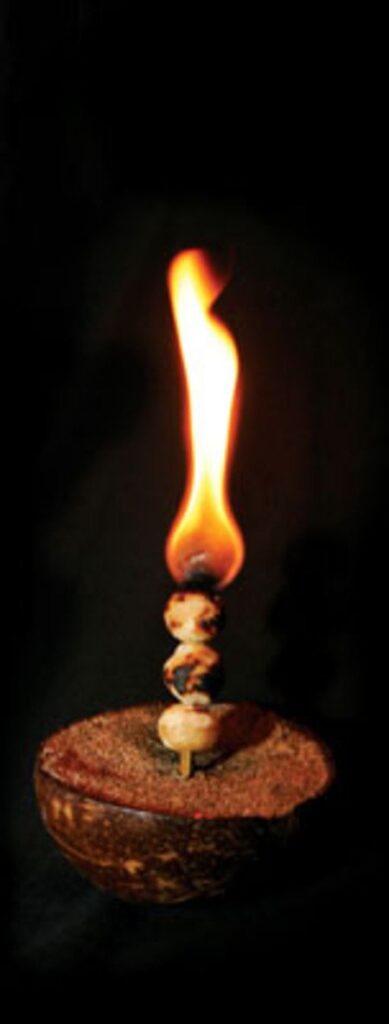A proverb is a simple and concrete saying, that expresses a truth based on common sense or the practical experience. They are often metaphorical. A proverb that describes a basic rule of conduct may also be known as a maxim.
Hawaiian proverbs are called ʻŌlelo Noʻeau; they have been handed down through the generations through Hawaiiʻs oral tradition. The sayings were gathered by Mary Kawena Pukui.
Here are a few random examples; they provide some food for thought.
I ka wa mamua, ka wa mahope
The future is in the past
Na wai hoʻi ka ʻole o ke akamai, he alanui i maʻa i ka hele ʻiae oʻu mau mākua?
Why shouldn’t I know, when it is a road often travelled by my parents?
(Reply of Liholiho when someone praised his wisdom.” Mary Kawena Pukui, ʻŌlelo Noʻeau 2301)
He Aliʻi ka ʻāina; he kauwa ke kanaka.
The land is a chief; man is its servant. (Mary Kawena Pukui, ʻŌlelo Noʻeau Pukui 531)
Land has no need for man, but man needs the land and works it for a livelihood.
Kama ʻia ke aloha a paʻa i loko.
Bind love that it may remain fast within.
Be a person who knows love.
E hoʻaʻo no i pau kuhihewa.
Try it to end the panic.
Often we stress out just worrying about doing a difficult job. “Just do it!”
Hahai no ka ua i ka ululaʻau.
The rain follows after the forest.
Destroy the forest, the rains will cease to fall.
O ka makapo wale no ka mea hapapa i ka pouli.
Only the blind gropes in the darkness.
If you have no direction in life, you’ll get nowhere.
I mohala no ka lehua i ke keʻekehi ʻia e ka ua.
The Lehua blossom unfolds when the rains tread on it.
People respond better to gentle words than to scoldings.
Pupukahi i holomua.
Unite to move forward.
By working together we make progress.
E lauhoe mai na waʻa; i ke ka, i ka hoe; i ka hoe, i ke ka; pae aku i ka ʻāina.
Paddle together, bail, paddle; paddle, bail; paddle towards the land.
If everybody works together the work will be done quickly.
I ka ʻolelo no ke ola, i ka ʻolelo no ka make.
In speech is life, in speech is death.
Words can either be a source for healing or destroying.
He lawaiʻa no ke kai papaʻu, he pokole ke aho; he lawaiʻa no ke kai hohonu he loa ke aho.
A fisherman of shallow seas uses only a short line; a fisherman of the deep sea uses a long line.
You will reach only as far as you aim and prepare yourself to reach.
Aʻohe hana nui ka aluʻia.
No task is too big when done together.
United we stand, divided we fall.
Lawe i ka maʻalea a kuʻonoʻono.
Acquire skill and make it deep.
Work hard and practice long until it becomes a part of you.
Kulia i ka nuʻu
Strive for the summit.
Strive for excellence.
Onipaʻa
(Be) steadfast.
Take your stand and be steadfast in doing what is right.
ʻIke aku, ʻike mai, kokua aku kokua mai; pela iho la ka nohana ʻohana.
Recognize others, be recognized, help others, be helped; such is a family relationship.
Put family first, you help others and know you will be helped if there is anything you need.
Makaʻala ke kanaka kahea manu.
A man who calls birds should always be alert.
One who wishes to succeed needs to be alert to any opportunity that should arise.
ʻAʻa i ka hula, waiho ka hilahila i ka hale.
When one wants to dance the hula, bashfulness should be left at home.
I ka ʻolelo no ke ola, i ka ʻolelo no ka make.
Life is in speech; death is in speech.
Words can heal; words can destroy. Be careful what you say.
ʻIke ʻia no ka loea i ke kuahu.
An expert is recognized by the altar he builds.
It is what one does and how well he does it that shows whether he is a expert.
He kehau hoʻomaʻemaʻe ke aloha.
Love is like cleansing dew.
Love removes hurt.
Nana ka maka, hoʻolohe ka pepeiao, paʻa ka waha.
Observe with the eyes, listen with the ears, donʻt talk.
This is how one learns best.
Piʻi mai nei i ka pali me he ʻaʻama lā
Climbs the cliff like a black crab.
Said of one who goes beyond his limit.
ʻO ke kahua ma mua, ma hope ke kūkulu
Learn all you can, then practice.
ʻIke aku, ʻike mai, kōkua aku, kōkua mai; pēlā ihola ka nohona ʻohana
Recognize others, be recognized, help others, be helped; such is a family relationship.
Family life requires an exchange of mutual help and recognition.
ʻIke ʻia no ka loea i ke kuahu
An expert is recognized by the altar he builds
It is what one does and how well he does it that shows whether he is an expert.
He ʻaʻaliʻi ku makani mai au; ʻaʻohe makani nana e kulaʻi
I am a wind resisting ʻaʻaliʻi, no gale can push me over.
In difficult times, when attacked, one stands strong.
The image shows the cover to Mary Pukui’s Book, ʻŌlelo Noʻeau.






















